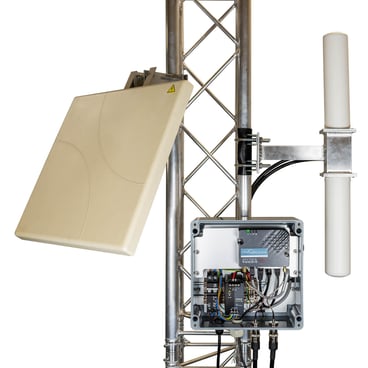Basics of satellite communication
If terrestrial networks such as landlines, mobile communications or the Internet fail, are overloaded or do not exist, satellite communication is the only alternative.

Examples:
- Failure of the terrestrial networks, e.g. in the event of widespread power outages, natural disasters, IT-related hazards
- Overloading of the terrestrial networks, e.g. on New Year's Eve, during major events such as the World Cup, or during major disasters
- Absence of terrestrial networks: on the world's oceans, in areas with poor infrastructure (e.g. remote areas without traditional communication options such as rural regions, but also forests, mountains, deserts and jungles)
What happens if common communication networks fail or are overloaded?
In emergencies such as long-term power outages, voice communication or data transmission is no longer possible after a short time in many areas of the public landline network, as both relay stations and end devices are no longer supplied with the necessary operating voltage.
After several hours*, internal landlines powered by UPS also fail. Furthermore, in the event of such a power failure, mobile radio base stations can no longer maintain communication in the corresponding radio cells if they do not have a suitable, long-term mains power supply.
Another problem is the heavy network load on mobile networks due to increased usage such as on New Year's Eve, major events such as the World Cup, major disasters, etc.
The lack of prioritization of SIM cards in the mobile network, for example for emergency services, also makes this medium an unreliable tool in an emergency.
Satellite communication, how does it work?
Satellite communication not only represents the only alternative to all terrestrial communication networks. It also allows for an infrastructure that these networks cannot offer due to technical limitations.
There are essentially two types of satellite systems for communication satellites:
Geo-stationary satellites that are fixed above the Earth at a distance of approximately 36,000 km. This system has excellent voice quality and high data transfer rates.
The second system uses so-called LEO (Low Earth Orbit) satellites, which orbit the earth at an altitude of approximately 780 km. The focus here is on voice communication and mostly low data transfer rates. Each device is connected to several satellites at the same time at any time.

Overview of satellite systems
The satellite systems are Inmarsat, Iridium, Thuraya, Globalstar, Echo-Star and various VSAT providers such as Eutelsat.
The various satellite systems differ, among other things, in:
- The type/positioning of the satellites (LEOs, MEOs, GEOs)
- The frequency band
- Your coverage
- The data bandwidth
- The connection quality
- The size of the end devices
- The prices of the devices
- Operating permits
- Import restrictions